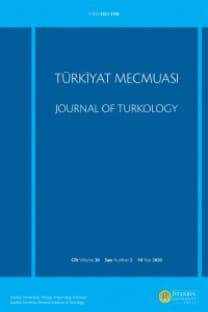RİSALE-İ KAÇACILIK (ÇÖMLEKÇİLİK RİSALESİ)
Kesbname, fütüvvetname, meslek, risale
PAMPHLET OF POTTERY
Kesbname, fütüvvetname, profession, pamphlet,
___
- ATA, Aysu, “Moğol Fütuhatı ve Doğu-Batı Türk Yazı Dili Kavramları Üzerine”, Ankara Üniversitesi Dil ve Tarih-Coğrafya Fakültesi Türkoloji Dergisi, 17 /1, 2010, s. 29-37.
- BOROVKOV, A. K., “K İstorii Bratstva ‘Ahi’ v Sredney Azii”, Akademiku Vladimiru Aleksandroviçu Gordlevskomu k ego Semidesyatipyatiletiyu İzdatel’stvo, Akademii Nauk SSSR, Moskva, 1953, s. 87-89.
- CLAUSON, Sir Gerard, An Etymological Dictionary of Pre-Thirteenth Century Turkish, Oxford, 1972.
- ECKMANN, Janos, “Çağatayca”, (Çev. Mehmet Akalın), Tarihî Türk Şiveleri, Türk Kültürünü Araştırma Enstitüsü Yayınları, 3. baskı, Ankara, 1988, s. 211-245.
- GÖLPINARLI, Abdulbaki, “Burgâzî ve ‘Fütüvvet-Nâme’s,”, İ.Ü. İktisat Fakültesi Mecmuası, XV/1-4, 1953-54, s. 76-154.
- GÜREL, Rahşan, Razavî’nin Fütüvvet-nâmesi (Fütüvvet-nâme-i kebir veya Miftâhü’d-dekâyık fi beyâne’l-fütüvveti ve’l-hakâyık), (M.Ü. Sosyal Bilimler Enstitüsü, Yayımlanmamış Doktora Tezi), İstanbul, 1992.
- KANAR, Mehmet, Arapça- Türkçe Sözlük, Say Yayınları, İstanbul, 2009. Konularına Göre Kur’an (Sistematik Kur’an Fihristi), (Haz. Ömer Özsoy, İlhami Güler), Ankara, 1997.
- KORKMAZ, Zeynep, Türkiye Türkçesi Grameri: Şekil Bilgisi, Türk Dil Kurumu Yayınları, Ankara, 2009.
- KÖPRÜLÜ, Fuad, “Çağatay Edebiyatı”, İslam Ansiklopedisi, C. III, 1945, s. 270-323. Mütercim Âsım Efendi, Burhân-ı Katı, (Haz. Mürsel Öztürk, Derya Örs), TDK Yayınları, İstanbul, 2009.
- NECİP, Emir Necipoviç, Yeni Uygur Türkçesi Sözlüğü, (Çev. İklil Kurban), TDK, Ankara, 2013.
- OCAK, Ahmet Yaşar, “Fütüvvetnâme”, İslam Ansiklopedisi, C. XIII, 1996, s. 264-265.
- ÖZTÜRK, Rıdvan, Yeni Uygur Türkçesi Grameri, TDK Yayınları, Ankara, 2010.
- STEINGASS, F., A Comprehensive Persian- English Dictionary, Beirut, 1998.
- TEKİN, Talat, Türk Dillerinde Birincil Uzun Ünlüler, Simurg Yay., Ankara, 1995.
- Yayın Aralığı: 2
- Başlangıç: 1925
- Yayıncı: İstanbul Üniversitesi Türkiyat Araştırmaları Enstitüsü
ŞEYḪÎ’NİN ḪUSREV Ü ŞÎRÎN’İNİN TÜRKİYE DIŞINDA BULUNAN NÜSHALARI
I. MEŞRUTİYET DÖNEMİNDE HARİCİYE NEZARETİNDE TENSİKAT VE BÜROKRATİK DEĞİŞİM (1908-1910)
RİSALE-İ KAÇACILIK (ÇÖMLEKÇİLİK RİSALESİ)
SARI ÂŞIK VE MÎR SEYYİD AKABÂLÎ NESLİ
OSMANLI’DA KISA ÖMÜRLÜ BİR HAYIR KURUMU: DULHANE (1884-1896)
SULTANIN CASUSLARI: 16. YÜZYILDA İSTİHBARAT, SABOTAJ VE RÜŞVET AĞLARI
